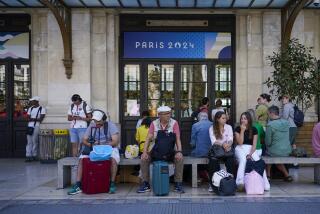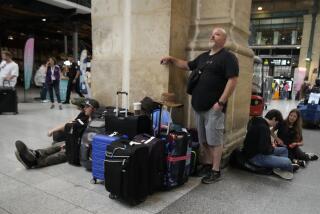Europe trains’ history of intrigue isn’t over
- Share via
Like many spy tales in fiction and reality, “Background to Danger” begins in a train station.
A down-and-out freelance journalist awaits a night train alone on a platform in Nuremberg, Germany, hands in overcoat pockets, shoulders hunched against a November wind. Soon a frightened Russian offers him cash to smuggle documents across the Austrian border, and the plot steams into a labyrinth of treachery.
The 1937 novel by Eric Ambler was part of a genre that explored Europe between wars, a cloak-and-dagger underworld where trains recur as a motif. “Stamboul Train” by Graham Greene depicts death and espionage aboard the Orient Express. In Alfred Hitchcock’s film version of John Buchan’s “The 39 Steps,” the hero -- framed for murder by foreign agents -- dodges police on a train in Scotland.
Fast-forward six decades into a transformed landscape. Europe has erased internal borders. Instead of fighting Nazis or communists, spy agencies use satellites and wiretaps to track Islamic terrorists who conspire on the Internet.
But one thing has not changed much. Trains, stations and the gritty neighborhoods that surround them are often the backdrop to danger.
Rail passengers were slaughtered in terrorist bombings in Paris in 1995 and Madrid nine years later. On a foggy Tuscan morning in 2003, a police ID check in a second-class compartment set off a point-blank shootout with a Red Brigades militant, the author of a manifesto proclaiming a leftist-Islamic militant alliance. Her companion and a police officer died.
And it was aboard a train to Paris that a Moroccan Belgian informant decided on a risky gambit after departing the Gare du Midi station here in the Belgian capital: Fearing betrayal by a handler, he surrendered to police and announced he was a spy. After his French and Belgian spymasters reconciled with him, they sent him on an undercover mission to Al Qaeda’s Afghan camps, according to his book “Inside the Jihad,” written under the alias Omar Nasiri.
Spies, terrorists, smugglers and other stealthy types use trains in Western Europe because they are fast, cheap and efficient. Unlike airports, rail travel also offers anonymity: Authorities don’t routinely check papers, search luggage or use metal detectors.
Moreover, train stations tend to be in working-class immigrant areas where desperadoes find shelter, weapons, false documents and other tools of the trade. The Gare du Midi, on the southern edge of downtown Brussels, is a good example. A few Spanish and Italian shops remain from previous migrations, but the personality of the neighborhood today is Moroccan and Turkish.
Lined by flower boxes and weathered facades, the Boulevard Maurice Lemonnier is the bustling main drag. Campaign posters of local politicians with first names like Ahmed and Fatima adorn a fish market, a halal butcher shop, a music shop blaring desert rhythms, a combination discount men’s store and travel agency.
Although this may not be the best sidewalk to stop and count cash, it is not bleak or menacing either. You have to know the secret history of this placid, cosmopolitan city to realize how many cases of skulduggery intersect in these few blocks.
At the Dar es Salaam, a hotel and tea house on a corner of the boulevard, hulking “shoe bomber” Richard Reid lay low in 2001 before taking the train to Paris and trying to bring down a Miami-bound jet with explosives-packed high-tops.
A few doors away at Le Nil, an Egyptian restaurant, police raids the same year uncovered a basement stockpile of bomb materials that an Al Qaeda cell had prepared for a plot against a U.S. target.
The clientele in the kebab joints, sidewalk cafes and restaurants is mostly male. The ambience ranges from industrious and respectable to furtive and thuggish. The latter probably marked the world of Abdelkader Belliraj, 52, a Belgian of Moroccan descent who has admitted to spying for Belgian intelligence and is now on trial in Morocco on a long list of charges.
For 20 years, Belliraj held court around here. He drank tea and ate couscous while allegedly hatching multimillion-dollar holdups, arms deals, money-laundering schemes and terrorist plots.
Prosecutors also accuse Belliraj of six murders, including political assassinations. But one killing was allegedly an act of punitive fundamentalism: a 53-year-old gay man gunned down because he picked up young Arabs around the Gare du Midi.
The crowds of travelers in the station, a hub for high-speed lines to Paris and London, are largely oblivious to this geography of intrigue. The architecture is functional, boxy and modern, lacking the ornate historic charm of stations in other capitals.
In 2005, a militant named Mohammed Reha held a sit-down at a train station in Brussels -- it’s not clear which one -- with the wife of an imprisoned terrorism suspect. The woman said that she and other wives of jailed extremists were ready to commit suicide bombings for Al Qaeda, according to his confession. Reha promised to put her in touch with a chief of the network, but he was soon arrested in Morocco and convicted in 2007 on terrorism charges.
Reha’s lawyers insist that the case was “fiction” concocted by unscrupulous authorities: a spy story. Either way, it features a colorful detail. Reha told interrogators that, as a precaution, he and the woman did not talk aloud about her offer to die for the cause. Instead, they sat and exchanged written notes.
In a train station, after all, you never know who might be listening.
--
More to Read
Sign up for The Wild
We’ll help you find the best places to hike, bike and run, as well as the perfect silent spots for meditation and yoga.
You may occasionally receive promotional content from the Los Angeles Times.






